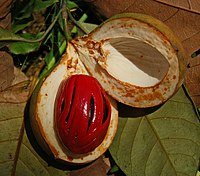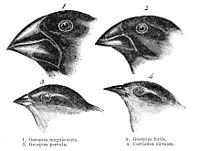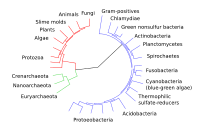
Plastid phylogenomics and molecular evolution of Thismiaceae (Dioscoreales).
Sign Up to like & getrecommendations! Published in 2023 at "American journal of botany"
DOI: 10.1002/ajb2.16141
Abstract: PREMISE Species in Thismiaceae can no longer photosynthesize, and instead obtain carbon from soil fungi. Here we infer Thismiaceae phylogeny using plastid genome data, and also characterize the molecular evolution of this genome. METHODS We… read more here.
Keywords: thismiaceae; loss; molecular evolution; gene ... See more keywords

Molecular evolution and phylogenomic analysis of complete chloroplast genomes of Cotinus (Anacardiaceae)
Sign Up to like & getrecommendations! Published in 2023 at "Ecology and Evolution"
DOI: 10.1002/ece3.10134
Abstract: Abstract Cotinus is an oligo‐specific ornamentally valuable genus with a disjunct distribution in the Northern Hemisphere. Traditionally, the taxonomy of Cotinus was mainly based on leaf morphological characteristics. However, the limited availability of genomic information… read more here.
Keywords: cotinus; chloroplast genomes; analysis; molecular evolution ... See more keywords

RNA editing by the host ADAR system affects the molecular evolution of the Zika virus
Sign Up to like & getrecommendations! Published in 2017 at "Ecology and Evolution"
DOI: 10.1002/ece3.3033
Abstract: Abstract Zika virus (ZIKV) is a mosquito‐transmitted flavivirus, linked to microcephaly and fetal death in humans. Here, we investigate whether host‐mediated RNA editing of adenosines (ADAR) plays a role in the molecular evolution of ZIKV.… read more here.
Keywords: evolution; molecular evolution; rna editing; zika virus ... See more keywords

Structure and molecular evolution of the barcode fragment of cytochrome oxidase I (COI) in Macrocheles (Acari: Mesostigmata: Macrochelidae)
Sign Up to like & getrecommendations! Published in 2022 at "Ecology and Evolution"
DOI: 10.1002/ece3.9553
Abstract: Abstract Consisting of approximately 320 species, Macrocheles is the most widely distributed genus in the family Macrochelidae. Though some studies have focused on the description of Macrochelidae using molecular techniques (e.g., RAPD) and sequencing of… read more here.
Keywords: structure molecular; molecular evolution; cytochrome oxidase; structure ... See more keywords

Synthetic Molecular Evolution of Cell Penetrating Peptides.
Sign Up to like & getrecommendations! Published in 2022 at "Methods in molecular biology"
DOI: 10.1007/978-1-0716-1752-6_5
Abstract: Rational design and optimization of cell penetrating peptides (CPPs) is difficult to accomplish because of the lack of quantitative sequence-structure-function rules describing the activity and because of the complex, poorly understood mechanisms of CPPs. Synthetic… read more here.
Keywords: cell penetrating; synthetic molecular; molecular evolution; penetrating peptides ... See more keywords

Application of Synthetic Molecular Evolution to the Discovery of Antimicrobial Peptides.
Sign Up to like & getrecommendations! Published in 2019 at "Advances in experimental medicine and biology"
DOI: 10.1007/978-981-13-3588-4_13
Abstract: Despite long-standing promise and many known examples, antimicrobial peptides (AMPs) have failed, with few exceptions, to significantly impact human medicine. Impediments to the systemic activity of AMPs include proteolysis, host cell interactions, and serum protein… read more here.
Keywords: medicine; molecular evolution; application synthetic; antimicrobial peptides ... See more keywords

Scratching the Surface of an Itch: Molecular Evolution of Aculeata Venom Allergens
Sign Up to like & getrecommendations! Published in 2018 at "Journal of Molecular Evolution"
DOI: 10.1007/s00239-018-9860-x
Abstract: Hymenopteran insects are infamous for their sting, and their ability to cause severe anaphylaxis and in some cases death. This allergic reaction is a result of allergens present in the venom. Hymenopterans have many common… read more here.
Keywords: surface itch; scratching surface; venom allergens; molecular evolution ... See more keywords

Insights into Dietary Switch in Cetaceans: Evidence from Molecular Evolution of Proteinases and Lipases
Sign Up to like & getrecommendations! Published in 2020 at "Journal of Molecular Evolution"
DOI: 10.1007/s00239-020-09952-2
Abstract: Fossil evidence suggests that cetaceans evolved from artiodactylans. Thus, there was a major dietary change from herbivorous to carnivorous during their transition from a terrestrial to an aquatic environment. However, the molecular evolutionary mechanisms underlying… read more here.
Keywords: molecular evolution; positive selection; proteinases lipases; evidence ... See more keywords

Molecular Evolution of Transition Metal Bioavailability at the Host-Pathogen Interface.
Sign Up to like & getrecommendations! Published in 2020 at "Trends in microbiology"
DOI: 10.1016/j.tim.2020.08.001
Abstract: The molecular evolution of the adaptive response at the host-pathogen interface has been frequently referred to as an 'arms race' between the host and bacterial pathogens. The innate immune system employs multiple strategies to starve… read more here.
Keywords: evolution; molecular evolution; transition; metal ... See more keywords

Molecular evolution of the plastid genome during diversification of the cotton genus.
Sign Up to like & getrecommendations! Published in 2017 at "Molecular phylogenetics and evolution"
DOI: 10.1016/j.ympev.2017.04.014
Abstract: Cotton (Gossypium spp.) is commonly grouped into eight diploid genomic groups, designated A-G and K, and one tetraploid genomic group, namely AD. To gain insight into the phylogeny of Gossypium and molecular evolution of the… read more here.
Keywords: evolution; molecular evolution; diversification; genus ... See more keywords

Molecular evolution: No escape from the tangled bank
Sign Up to like & getrecommendations! Published in 2017 at "Nature"
DOI: 10.1038/nature24152
Abstract: Ecological interactions emerge spontaneously in an experimental study of bacterial populations cultured for 60,000 generations, and sustain rapid evolution by natural selection. See Letter p.45 The Escherichia coli long-term evolution experiment (LTEE) is the longest… read more here.
Keywords: evolution; molecular evolution; escape tangled; 000 generations ... See more keywords